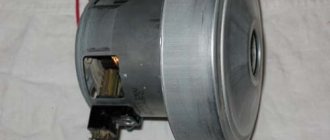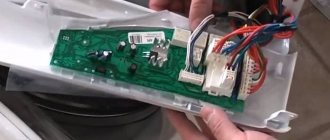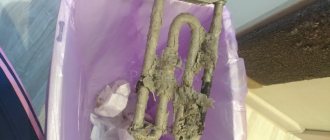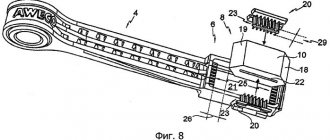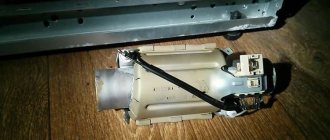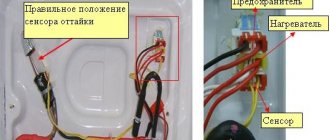Is it possible to do it yourself?
Vacuum cleaners have two types of bags: disposable and reusable. Disposable ones are convenient because you don’t need to shake out the trash; after cleaning, they are immediately thrown away. They are made from filtered paper. It allows air to pass through, but particles of dust and debris are retained in it. Less commonly, such dust collectors are made from synthetic fabric folded in several layers. They are stronger and can be used for multiple cleanings. But after filling, they still need to be thrown away. Constantly buying new bags can be expensive. And for each vacuum cleaner model they are different.
That's why many people use reusable dust bags. After filling, they are shaken out and reinserted into the vacuum cleaner. To do this, there is a clasp or plastic clip on the back side. They are made from denser material. But it must allow air to pass through well, otherwise the motor will work with overload.
To properly make a vacuum cleaner bag with your own hands , you must take into account the recommendations of experts:
- it is important to choose the right material;
- it must be made according to the model of an old dust collector;
- It is better to use Velcro or a plastic clip for the fastener, as the zipper gets clogged quickly.
Note! An incorrectly made, improperly sized or low-quality dust collector can ruin the vacuum cleaner.
Types of bags
Vacuum cleaner bags are disposable and reusable. Before you get started, you need to find out what type of dust collector is in your vacuum cleaner. Reusable and disposable are made from different materials.
The disposable bag is made of multi-layer breathable paper.
At first glance, the product looks like a simple paper bag equipped with a cardboard frame for sucking up debris. The bags are made from multi-layer filtered paper, which gives it strength and breathability.
pylesos_tech
Reusable, made of synthetic fabric that is highly breathable. There is a hole at the bottom of the bag for removing debris. This hole can be equipped with a zipper or a plastic lock.
To make bags at home, natural or synthetic dense fabric is suitable.
What material can you sew from?
For the dust collector you need to choose the right material. Disposable ones are made from paper or cheap synthetic fabrics. Paper is convenient because it is easy to make a bag out of it, and after cleaning it you just need to throw it away. Disposable dust collectors are convenient for collecting small household waste, as long as it is not wet. If the dust bag ruptures, the engine may become clogged.
A reusable vacuum cleaner bag is best made from synthetic fabric. It is better to take spunbond material. It allows air to pass through, but the pores are so small that particles of dust and debris cannot pass through. Therefore, it works as an additional filter. This fabric is durable, easy to wash and does not deform. Its density varies, for a bag it should be at least 80g/m2.
You can also use teak, which is a cushion fabric. It is also breathable, but durable and does not allow dust particles to pass through. You can make a dust collector from non-woven fabric, but you will have to fold it several times. Denim or corduroy can be used from dense materials, the main thing is that they allow air to pass through well.
Production of filter materials
The variety of filter materials is due not only to the dynamic development of textile production, but also to the modernization of systems for cleaning the environment from harmful emissions.
Filter fabrics are made from natural or synthetic fibers with a diameter of 10-30 microns, twisted into threads with a diameter of up to 0.5 mm. The distance between the threads is usually 100-200 microns. The weft and warp threads form a mesh, which can additionally be intertwined with fibers. Contaminated air, liquid or gas, passing between the threads, is cleaned, leaving a sediment on the surface of the material. The presence of lint improves the filtering ability of the fabric. The principle of operation of the filter resembles a sieve - it passes purified air, liquid, oil through it, trapping various contaminants on the surface.
Important! The fabric comes into working condition after several cycles of contamination and cleaning. After some time, a residual dust layer forms on the fabric, which forms an additional filter. As a result of the continuous filtration process, this layer, together with the fabric's resistance, is stabilized and preserved. When dust gets stuck in the pores of the fabric, moisture condenses on the surface or becomes oily, the fabric's resistance increases.
You might be interested in this. Features of the staple: fabric components, material characteristics
Production of filter materials
Drawings, diagrams, dimensions
For the incoming hole you will need a piece of thick cardboard measuring 30x15 cm. Cut it in half. In the middle of each workpiece, draw a circle along the diameter of the hose inlet. In some models, the dust collector is secured with a plastic holder. Such a mount can also be made from thick cardboard or removed from an old bag.
The piece of material should be 1-1.5 m in size. It is better to make a bag from fabric folded in half or three. Use an old dust collector as a pattern. If this is not possible, you need to take measurements from the vacuum cleaner. To do this, open the lid and measure the length and width of the compartment.
Attention! It is necessary to make seam allowances of at least 1-2 cm. Without this, the finished dust collector will be smaller than necessary, which will negatively affect the operation of the vacuum cleaner.
Disposable bag
Let's start by preparing all the tools and materials we need.
We will need:
- thick cardboard measuring 30 by 15 centimeters;
- Scissors;
- Glue;
- Stapler or thread;
- Thick fabric, for example, spunbond or thick paper. Such material is sold in any hardware store. We will need about one and a half meters of it. It all depends on what size bag we need.
Preferably! so that before your eyes there is a clean, original dust collection bag designed specifically for your vacuum cleaner model.
You can use as a sample.
We fold thick fabric (spunbond) in half and secure it in this position using a stapler or thread. This is done so that even fine dust or pollen does not have the opportunity to leave the filter and end up back in the room.
Now we fold our fabric so that we get a bag.
We also secure its neck with a stapler. We fasten the staples at a distance of two millimeters from each other.
The resulting dust collector must be turned inside out. This is done to ensure that all fastenings with a stapler remain on the inside. We measure the diameter of the inlet hole in the dust collector compartment. Using its parameters, we draw and cut out two holes on two small square pieces of cardboard.
Remember! You need to add a couple more millimeters to the measured diameter for landing docking.
two pieces of cardboard with a round cutout in the middle on one side with glue (preferably the glue is Moment).
We thread the neck of our bag into one of the cardboards so that the side coated with glue is on top. We place the second cardboard on it, but with the glue-coated side down. It turns out that the neck of the bag is clamped between two pieces of cardboard and fixed with glue.
For reliability, you can secure the neck of the bag between the cardboards by walking along the edge with a stapler . Our dust collector is ready to use. All that remains is to insert it into the appropriate compartment of the vacuum cleaner.
Read how to care for your vacuum cleaner bag here.
Important! If you use paper, it should be of such density that sharp debris cannot damage it by barely touching it!
After use, the dust container is simply removed and thrown into the trash. Now you know how quickly and easily you can make a disposable dust collector with your own hands.
If you fold thick fabric not in two layers, but in three. The density of the bag will increase, and hence the efficiency of the filter.
Bag dust collector
The main part of a vacuum cleaner, of course, is the engine, but without a device for collecting sucked debris, any vacuum cleaner will turn into an ordinary compressor for pumping air. In such vacuum cleaners, garbage bags are divided into two main categories:
- Disposable, designed to collect garbage during cleaning, after which the entire bag with contents is thrown into the trash.
- Reusable, they also accumulate debris drawn in by the vacuum cleaner, but unlike the previous ones, they are equipped with devices for cleaning the reusable bag from collected debris.
A distinctive feature of disposable bags is that they are hygienic in terms of removing debris from the dust container. The person himself does not come into direct contact with the garbage; after the cleaning is completed, ideally the bag is simply removed from the grooves. In practice, housewives change such bags after a certain period of time or number of cleanings. Disposable paper bags hold trash much better than reusable fabric bags. Reusable vacuum cleaner bags are used much longer than disposable ones and do not require frequent spending of money on purchasing new bags. But they are also characterized by a number of disadvantages:
- Due to the porous structure of the material, the cells of the reusable bag dust collector allow finely dispersed dust fractions to pass through.
- They require periodic washing, since regular shaking of the bag does not provide a complete cleaning effect;
- If wet debris and liquid fractions are collected or the washed bag does not dry completely, fabric vacuum cleaner bags become breeding grounds for bacteria, mold or fungi.
- When cleaning a reusable bag, the dust and debris contained in it end up on your hands and in your respiratory tract.
Bag for a vacuum cleaner - we create it ourselves
A DIY vacuum cleaner bag is quite easy to make and will not take more than 15-20 minutes . We take spunbond (1-1.6 meters) and fold it in half, so the bag will be denser and will not let in even the smallest debris. We bend the edges tightly, leaving only one “entrance”, fasten with a stapler, the step is best done no more than 2-4 mm. Afterwards, we turn it inside out to hide the staples of the stapler.
Cardboard is next. We measure the diameter of the inlet hole of your vacuum cleaner, draw it on cardboard , in the amount of 2 copies, add a few millimeters for the mounting diameter, cut it out, apply glue in large quantities . We glue one rectangle inside the bag, right in the middle, and the other, we glue it on it, but only on the outside. Using scissors, cut a hole making a “star”. To consolidate the effect, we go over the cardboard with a stapler . Finally, we wrap the rest of the bag and fasten it with a stapler.
Reusable bags: pros and cons
The main advantages of reusable containers are their low price and durability. DIY dust collectors will cost you much less than disposable ones. Such bags are durable and will not tear during the first cleaning, and can also withstand the impact of sharp objects. Moisture does not harm them. Such containers have electrostatic filtration. The only downside is that microbes trapped in the dust collector cause a foul odor, which is why fragrances should be used.
Both disposable and reusable dust collectors have their pros and cons. However, it is much easier to make a dustbin for a vacuum cleaner with your own hands than to purchase one at an inflated price.
If you are tired of cleaning and changing dust collectors, pay attention to bagless or washing models of vacuum cleaners.

